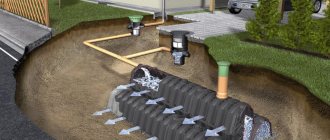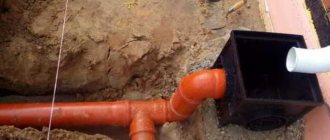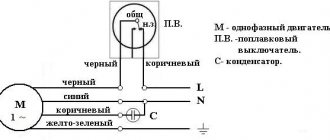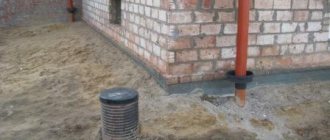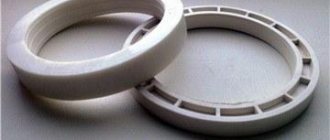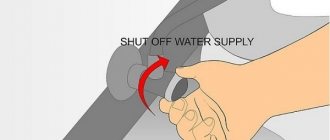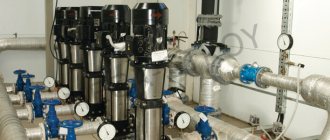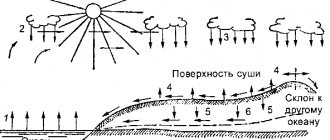Types of storm drainage
The division of types of storm drainage goes in two directions:
- by system type;
- by type of location in relation to the surface of the earth.
By type of system it means point and linear sewerage, and by location - open and closed.
Point system
This type refers to a number of storm water inlets installed under the gutters of buildings. When combined, they create a single fluid drainage system. This storm includes:
- Water intakes, also called storm water inlets;
- The ladders along which the fluid moves;
- Septic tanks in which garbage settles;
- Drainage;
- Storm well.
Stormwater inlets are installed in places where moisture accumulates, including entrances to the site, areas in front of entrance doors, under drainpipes that come from roofs, and in other low places.
Linear system
Under this name lies a more complex type of drainage of wastewater from buildings and areas adjacent to them. Water intakes are complemented by a collector and a network of channels made of pipes or trays. In a number of situations, it may be necessary to install door trays, which also work on the principle of storm water inlets, but are located in front of doors, gates and gates. The construction of a linear type storm sewer is necessary if:
- The site has a slope of 3° or more;
- In the development region there is a risk of flooding during flood periods or when it rains frequently;
- The site is located on the slope of a hill.
A linear storm sewer system is an entire drainage system that consists of a drainage channel, filters, gratings and a catch basin. Such a storm drain collects moisture not only from gutters located on the roof, but also from paths or concreted areas.
The design of storm drainage requires preliminary drawing up of a diagram of drainage lines. To build an open storm drain, trays are installed in small recesses. They are covered on top with metal or plastic grilles. The gutters are laid so that, due to the slope, the liquid moves by gravity. From the gutter, water goes into the sand trap, and then into the storm drain.
When implementing a linear system, a number of nuances prescribed in SNiP are taken into account, including the type and depth of pipes, and the slope of the sewer system.
External storm drainage
The drains that are located along the paths are a prime example of such a system. It involves the use of drainage trays, which are covered with gratings. The design of this sewer system is relatively simple and convenient both during installation and operation. Drains are easy to clean if there are blockages or other contaminants, and damaged areas can be easily replaced with new ones.
Internal storm drainage
Such a sewer system is a more complex option that requires careful calculations during design. If we talk directly about the installation of storm sewers, then difficulties often arise here, since it is necessary to carry out a large amount of work with digging trenches and their equipment, subsequent laying of pipes, and installation of inspection wells. But such a storm drain can handle literally any volume of wastewater.
External and internal sewerage systems are often combined into a mixed type of system to obtain a stormwater system with maximum performance at lower costs.
Integrated water resources management
A rain garden designed to treat stormwater from an adjacent parking lot
Integrated Water Management (IWM) of stormwater can solve many of the problems affecting waterways and water supply issues facing the modern urban city. IWM is often associated with green infrastructure when considered in the design process. Professionals in their fields, such as urban planners, architects, landscape architects, interior designers and engineers, often consider integrated water management as the foundation of the design process.
Also known as low-impact development (LID) in the United States or water-saving urban design (WSUD) in Australia, IWM has the potential to improve runoff quality, reduce the risk and impact of floods, and provide additional water resources for increased drinking water supply. supply.
Modern city development often results in increased demand for water supply due to population growth, while at the same time altered flows predicted by climate change can increase the volume of stormwater, which can contribute to drainage and flooding problems. IWM offers several methods, including stormwater harvesting (to reduce the amount of water that can cause flooding), infiltration (to restore natural groundwater recharge), biofiltration or biological retention (such as rain gardens), to store and treat runoff and discharge it . at controlled rates to reduce impacts on streams and wetland treatments (to conserve and control flow rates and provide habitat in urban areas).
There are many ways to achieve LID. The most popular of these is the use of above-ground solutions to reduce stormwater runoff through the use of catch basins, biosaurs, infiltration trenches, resilient pavements (such as permeable pavement), and others mentioned above. LID can also be achieved by using engineered, manufactured products to achieve similar or potentially better results as above-ground systems (underground storage tanks, stormwater treatment systems, biofilters, etc.). The right LID solution is one that balances the desired outcomes (runoff and pollution control) with the associated costs (loss of usable land for above-ground systems versus the capital cost of the solution being manufactured). Green (vegetated) roofs are also an inexpensive solution.
IWM as a movement can be seen as being in its infancy and combining elements of drainage science, ecology and the awareness that traditional drainage solutions carry problems further downstream to the detriment of the environment and water resources.
What does a storm drain consist of?
A storm drainage project typically includes the following elements:
- Storm water inlets . These are water collection points installed under building drains, in ditches, and other low places.
- Gutters and channels . They are responsible for transporting moisture.
- Sand traps or other filters . They prevent debris or petroleum products from entering the sewer system.
- Inspection wells . Installed for periodic cleaning and checking the operation of the system.
- Pipes . All elements of the system are connected to each other.
- Collectors are reservoirs into which wastewater flows.
The type and number of elements are determined in accordance with the scale of the stormwater system, the amount of water removed from the site and other factors.
Regulatory documents for analysis
Requirements and standards for the analysis of wastewater (storm water) for enterprises are set out in the following documents:
- SanPiN 2.1.7.1322-03 “Hygienic requirements for the disposal and disposal of production and consumption waste”;
- GOST 31861-2012 “Water. General requirements for sampling”;
- Federal laws: “Water Code of the Russian Federation” dated 06/03/2006 N 74-FZ Article 44 (as amended and supplemented as of 01/01/2019;
- “On Environmental Protection” dated January 10, 2002 No. 7-FZ;
- “On production and consumption waste” dated June 24, 1998 No. 89-FZ;
- “On the sanitary and epidemiological welfare of the population” dated March 30, 1999 No. 52-FZ;
- “On Environmental Expertise” dated November 23, 1995 No. 174-FZ;
- “On approval of water quality standards for water bodies of fishery importance, including standards for maximum permissible concentrations of harmful substances in the waters of water bodies of fishery importance” dated December 13, 2016 N 552.
Calculation of rainwater drainage performance
Installation of storm drainage requires a preliminary calculation of the performance of the rainwater system. In this case, the formulas given in SNiP 2.04.03-85 are taken as a basis. The maximum fluid flow rate is determined by the formula:
V = q20 * S * D,
Where V is the maximum fluid flow;
q20 – precipitation intensity in a particular region (taken from the table given in SNiP);
S – roof area;
D – coefficient reflecting the degree of moisture absorption by the material. This value is also found in SNiP.
Content
- 1 Storm water pollution
- 2 Stormwater as a source of pollution
- 3 Urban flood
- 4 Stormwater creating a sinkhole
- 5 Stormwater management 5.1 Technical aspects
- 5.2 Institutional and political aspects
- 7.1 US 7.1.1 Federal requirements
Selection of pipes for storm drainage
Pipes for rainwater drainage are not laid to great depths. They are not involved in transporting water under pressure or at high temperatures. That is why there are no strict restrictions on the use of such products. According to SNiP, the use of metal, concrete, and plastic pipes is allowed, but most often plastic products are used. They are much lighter, cheaper and more accessible than their analogues. They are also much easier to work with during installation and maintenance.
If we talk about the parameters of pipes that storm drainage products should have, the following stand out:
- Frost resistance . That is, exposure to low temperatures should not lead to destruction of the pipe structure.
- Reliability . The product must be resistant to chemicals, external soil pressure, corrosion, and rotting.
- Roughness . This parameter is especially important for internal walls. Smooth walls will not allow dirt, debris, or plaque to be deposited on the surface, and therefore the stormwater system will operate for a long time without interruption.
- Bandwidth . It must be at a high level to prevent flooding of the area.
- Hydraulic resistance . It should be small. This is achieved due to the smoothness of the inner walls of the product.
- Long length . The longer the pipe sections, the easier the sewer construction will be.
Plastic pipes for the storm drainage system must comply with all SNiP requirements for external sewerage systems. Polyethylene corrugation and polyvinyl chloride rolled products are especially popular among stormwater pipes.
PVC is considered a more economical option, which is quite easy to install when installing a sewer system. This type of plastic has a long service life - about 50 years. PVC pipes for stormwater drainage are usually produced in orange color with a diameter of 110-160 mm. Their only drawback lies in their high rigidity, which makes it impossible to bend the pipe in the desired direction. In order to change the direction of the pipeline, special fittings are used.
Corrugated pipes are more flexible, due to which a much smaller number of fittings are used during installation. They are easy to purchase in a whole bay up to 100 meters long. The upper ribbed layer gives high ring rigidity.
Story
Ever since people started living in concentrated villages or cities, stormwater runoff has become a problem. During the Bronze Age, housing took on a more concentrated form and impermeable surfaces became a factor in the design of early human settlements. Some early adoption of engineered stormwater systems is seen in Ancient Greece.
A specific example of an early stormwater drainage system design can be found during the archaeological excavations at Minoan Phaistos in Crete.
Pipe depth
In SNiP, issues related to the depth of pipes are addressed very simply. The minimum indicator is determined empirically, that is, you need to focus on storm sewer systems that have already been put into operation in the region.
For pipes with a cross-section of up to 500 mm, the minimum depth is considered to be 30 cm. Large pipe diameters require greater depth - at least 70 cm. These figures are correct for the regions of the middle zone.
But in order not to be mistaken in your calculations, it is enough to obtain practical knowledge on this issue from neighbors who have already tested stormwater in their own experience, or ask people or companies that install stormwater systems. The last option is the most reliable, since the answer is given from specialists with relevant experience and education.
How is installation carried out?
Before installation, a specialist studies the design of the drainage system. When all the nuances have been agreed upon and the materials for implementing the plan have been selected, the storm drain itself is installed:
- Construction of storm drainage begins from the top point. This is usually the roof of the house. Gutters are installed along the perimeter of the roof, taking into account the slope and the choice of the point of discharge of water into a rainwater inlet or channel.
- Next, the pipeline, channels, receivers and wells are marked.
- When the markings are made, trench digging begins. A sand cushion is installed in it. To prevent root growth in the area where pipes are laid, geotextiles must be installed.
- Installation begins with the installation of collectors or wells. Next come other elements - rainwater inlets, sand traps, trays.
- The next stage is to combine all the elements with pipes. When laying them, sagging is unacceptable.
- Once the structure is assembled, it is tested. If there are no errors, the system is filled with sand-cement mixture and soil.
If it is nevertheless decided to combine storm and drainage sewers, then the collector well must be selected with a large volume. But most often these systems have separate drainage tanks.
Treatment facilities for highways
Wastewater treatment systems in their classic form are complex structures that irreversibly change the appearance of the landscape and are capable of having their own impact on nature. As practice shows, treatment facilities in the form of special filtration basins that naturally fit into the landscape can be successful here. Also, these structures do not require foundations and other bulky structures. Experimental technology for treating wastewater from roads in filtration basins using natural sorbents was created back in the 90s of the 20th century and was implemented in several projects that proved the high efficiency of water purification from oil industry products, suspended substances and heavy metals. In this case, the filtration pool is created artificially and imitates the natural process of water purification in natural conditions. The movement of water in such a system occurs by gravity and does not require the use of pumping equipment. Purification processes are carried out by mechanical, physico-chemical and biological methods. Chemical methods are not used - this means that there is no need to organize the transportation, storage and use of hazardous reagents in order to avoid accidents or leaks. The principle of operation of such a system is as follows: water from the surface of a road, bridge or overpass is collected in drainage trays, after which it is moved by gravity to the primary settling tank for gravity purification. In this settling tank, the film of petroleum products and large fractions of suspended substances are separated. After this, the liquid enters the filtration basin, where it percolates through a layer of sorbent material and is cleaned of heavy metals, the bulk of petroleum products and suspended solids. Wastewater purified in this way is discharged into a natural reservoir. Garbage, mechanical sediment and oil film are collected, disposed of and stored. As necessary, sorbent materials are replaced. For waterproofing filtration basins, bitumen mastic is used to prevent wastewater from seeping into the ground and underground reservoirs.
What not to do when installing a drainage and storm sewer system
During floods and rains, the volume of water is so large that the throughput of the system is barely enough to drain the entire volume of liquid. Therefore, when installing the system, it is impossible to direct wastewater into ring drainage wells.
Storm and drainage sewer pipes are laid parallel to the drainage point. The well must have a capacity that can handle the maximum amount of rainfall that is typical for your region. If rainwater is directed into the drainage system, then the following situation arises:
- Rainwater fills the storage tank, which is not designed for large volumes of water, very quickly.
- The wastewater rises above the level where the pipes enter the container and flows back into the drainage system.
- The entire drainage system is filled with water under pressure. Instead of draining wastewater, the soil will be oversaturated with water, which will be supplied from both the drainage and the stormwater drain.
- Rainwater contaminated with suspended particles, entering the drainage system, clogs holes and channels, rendering the pipe system partially or completely unusable.
Eliminating the consequences of such ill-conceived storm sewer design will have to cost quite a tidy sum. Therefore, preliminary design, the correct choice of plastic pipes and other elements of stormwater and drainage will not only save money in the future, but also prevent a number of problems with systems.
Urban flood
Stormwater Management Reservoir
Stormwater is the leading cause of urban flooding. Urban flooding is the inundation of land or property in a built environment caused by stormwater exceeding the capacity of drainage systems such as storm sewers. Although urban flooding is caused by single events such as flash floods or snowmelt, it is a condition that is characterized by repeated, costly, and systemic impacts on communities. In areas prone to urban flooding, check valves and other infrastructure may be installed to reduce losses.
Where properties are built with basements, urban flooding is a major cause of basement and sewer duplication. Although the number of victims of urban flooding is usually limited, the economic, social and environmental impacts can be significant: in addition to direct damage to property and infrastructure (highways, utilities and services), chronically damp homes are associated with an increase in respiratory diseases. problems and other illnesses. Sewer backup often comes from a sanitary sewer system that receives stormwater through infiltration/inflow.
Urban flooding has serious economic consequences. In the US, industry experts estimate that wet basements can reduce property values by 10 to 25 percent and are cited as one of the top reasons for not buying a home. According to the Federal Emergency Management Agency, nearly 40 percent of small businesses never open their doors after a flood. In the UK, urban flooding is estimated to cost £270 million per year (as of 2007) in England and Wales; 80,000 homes are at risk.
A study in Cook County, Illinois, found 177,000 property damage insurance claims in 96 percent of the county's ZIP codes over a five-year period from 2007 to 2011. This is equivalent to claiming one in six properties in the county. The average payout per claim was $3,733 across all claim types, with a total payout over the five claim years of $660 million.
An example of an urban flood control project is the Brays Bayou Greenway Framework project in Houston, Texas. Brays Bayou and its tributaries drain an approximately 88,000-acre watershed south of downtown Houston. The federally funded improvement project created a short-term solution by improving the drainage capacity of the bay and identified a wide range of potential recreational and open space opportunities along 35 miles of the bay and tributaries.
